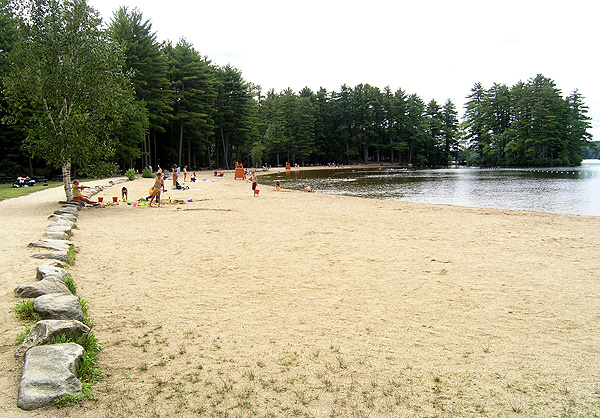A Morning By The Lake
![]() Each Monday we write about the New England environment and way of life seen through our local perspective. Previous posts
Each Monday we write about the New England environment and way of life seen through our local perspective. Previous posts
By Amy Miller
My family arrived at our campsite to a gray, evening drizzle. Not too wet to enjoy a kayak, nor too wet to keep us from making a fire and eating turkey dogs off sticks. The beach umbrella propped against a picnic table was ample protection. And we got our reward for persevering. “It doesn’t get much better than this,” remarked a woman on the lake trail as she ogled the double, 180-degree arch of vibrant color like you only expect in children’s books. I looked for the pot of gold.
The rain stopped in time to set up in the dark. The winds whispered above, sending droplets onto our tent. By morning the sky was clear and the islands of Pawtuckaway Lake were calling us out in our kayaks.
Pawtuckaway State Park sits in the middle of southern New Hampshire. Straddling the towns of Raymond and Nottingham, Pawtuckaway has trails, waterfront campsites, rock walls, marshes and a lake with nooks, crannies, big islands, little islands, blueberry-filled islands and a beach.

Unfortunately, it also can have contamination. The beach was half-closed when we were there. Not totally closed, but trimmed with yellow warnings signs that it might not be safe to swim. The problem, according to a nice woman who got my phone call, is that sometimes the bacteria count is too high at the beach. It was only 125 counts per 100 milliliters of water, close to the 88 count cut-off. Outside the beach area the lake was fine, and a few days later, by August, it was all fine again. The bacteria is caused by people and animals, mainly geese and recreating crowds. Beavers and other animals that love the marshes don’t help, nor does rain. But the warning signs didn’t seem to bother the hundreds of people grilling recipes from India, Malaysia, Dominican Republic, Jamaica and Maine. The sun blazing overhead, dozens of people were splashing about happily.
The state tests the water every other day or so. Since 1996, and more regularly since 2000, they have taken 461 samples. Of those, 34 have come back above acceptable standards. The geese, and people who feed them, are apparently among the first offenders.
When we tumbled out of our tent in the morning, a great blue heron was sitting comfortably at the water’s edge, as if to say “Welcome to my campsite; you may stay, if you like.” We stared at him for about 30 minutes.
Then we decided to make breakfast, smokey toast and hot cocoa. We knew not to share it with the ducks, and the heron knew not to ask.
More EPA info on beach monitoring in New England states, including New Hampshire lakes.
About the author: Amy Miller is a writer who works in the public affairs office of EPA New England in Boston. She lives in Maine with her husband, two children, eight chickens, dusky conure, dog and a great community.
